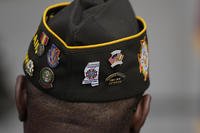The U.S. Air Force is preparing for possible mass evacuations of coronavirus-infected patients by testing whether it can transport dozens of people onboard its aircraft without first isolating them in containment capsules.
Earlier this month, Air Mobility Command, in tandem with researchers from the National Strategic Research Institute at the University of Nebraska and the Defense Advanced Research Projects Agency, conducted weeklong airflow experiments on six different aircraft. The goal was to analyze how air travels through a cargo hold using specialized, traceable droplets, said Maj. Dave Sustello, AMC's Test and Evaluation Squadron operations officer.
Organized by the 155th Air Refueling Wing at the Nebraska Air National Guard base, crews studied particle flow on the KC-135 Stratotanker, C-17 Globemaster III and C-130J Hercules aircraft, followed by tests on the KC-46 Pegasus, KC-10 Extender and C-5M Super Galaxy aircraft, which all have the capacity to transport multiple passengers, he said.
Related: Air Force Uses Cutting-Edge Isolation Pod to Evacuate COVID-19 Patients from Afghanistan
"In any of these aircraft, the air flows from the front to the back, which is a good thing," Sustello said in an interview with Military.com Tuesday. "It's pushing air away from the crew members.
"But these aircraft are very different," he said. "They have different configurations inside, different environmental systems, so we're looking to see where that air flows and if any of the air could flow back towards the pilots or the aircrew compartments."
Loadmaster airmen can reconfigure the belly of these aircraft to accommodate seats or stacked, bunk-bed-like cots for personnel transport. In cases of aeromedical evacuation, crews can even construct a portable medical care system, turning the inside of the aircraft into a makeshift emergency room.
"There are many different configurations for each plane, because you can set up as many [bunk bed-like] litters as it can hold, but also balanced with how many seats are available for ambulatory patients," Sustello said.
With that in mind, the operations officer explained engineers first took geometric scans within each aircraft to determine internal compartment scale, which would help them recreate similar models via computer-aided design. Then, multiple tests were done while in flight and also on the ground, he said, aided by experts from the 711th Human Performance Wing and the Air Force Research Lab, both headquartered at Wright-Patterson Air Force Base in Ohio.
NSRI researchers released polystyrene latex microspheres, or particles roughly one to three microns in size "to simulate the size of the novel coronavirus," he said. The particles also had a signature, so they could be tracked whenever they traveled within the plane.
"They were tagged with fluorescent dye with a specific DNA signature," Sustello said. The test would not only evaluate how many of the spheres were found in each part of the aircraft, but also exactly "where they came from," he said.
The goal is to understand if patients could be moved safely without using the Transport Isolation System, or TIS. Earlier this month, aircrew and medical personnel used the TIS for the first time since the Ebola outbreak to carry three U.S. government contractors who tested positive for coronavirus on board a C-17 from Afghanistan to Landstuhl Regional Medical Center in Germany. The TIS, however, can only carry two to four patients within the airlocked unit.
The TIS "is a very conservative system," Sustello said. The Air Force has 13 fully configured mission-ready TIS units.
"We're looking at more of an open-air approach [where we] can take a lot more passengers that are possibly infected or definitely infected and move them to where they need to get care while still minimizing the risks to the crew."
Results from the experiment for the KC-135, C-130 and C-17 are expected to be delivered to Air Mobility Command and U.S. Transportation Command by the end of the week. Results from the remaining three aircraft should be ready next week, Sustello said.
The findings may also benefit other agencies, he said.
"It's up to Air Mobility Command leadership to decide how that would be shared," Sustello said. "It's likely that the Civil Reserve Air Fleet [could] be activated ... as a civilian component of the United States Transportation Command's mission, and I would imagine that we would share these results with them."
TRANSCOM "expressed a need for a high-capacity airlift of COVID-19 infected passengers," Sustello said. "There are a lot of cases popping up and we're always looking for ways to be ready for the next fight, and that fight is here in COVID-19.
"We need to figure out how we're going to get a mass amount of patients or COVID-19 positive personnel to where they need to get the best care," he said.
-- Oriana Pawlyk can be reached at oriana.pawlyk@military.com. Follow her on Twitter at @Oriana0214.
Read More: 'Elephant Walk' on Guam Serves As Timely US Airpower Demonstration













